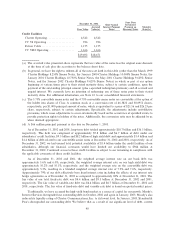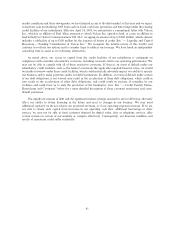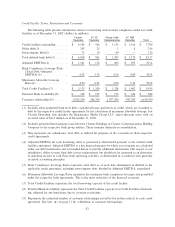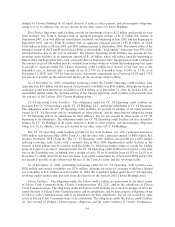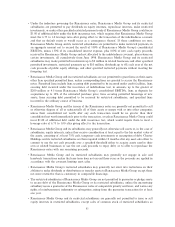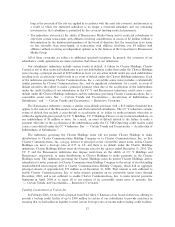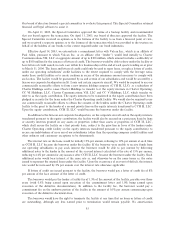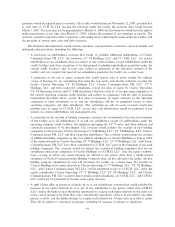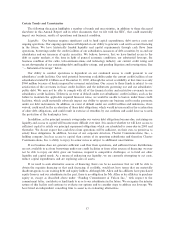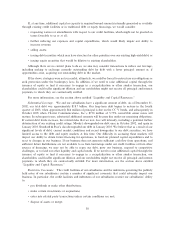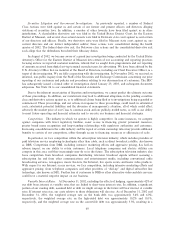Charter 2002 Annual Report Download - page 52
Download and view the complete annual report
Please find page 52 of the 2002 Charter annual report below. You can navigate through the pages in the report by either clicking on the pages listed below, or by using the keyword search tool below to find specific information within the annual report.restricted subsidiaries are then required within 360 days after any asset sale either to commit to use the
net cash proceeds over a speciÑed threshold either to acquire assets, including controlling assets in
permitted businesses, make capital expenditures or use the net cash proceeds to repay debt, or to oÅer
to repurchase the CC V notes with any remaining proceeds.
‚ The CC V issuers and their restricted subsidiaries may not engage in sale and leaseback transactions
unless, at the time of the transaction, the applicable CC V issuer or restricted subsidiary could have
incurred indebtedness under the leverage ratio test described above in an amount equal to the present
value of the net rental payments to be made under the lease, the gross proceeds of the sale are at least
equal to the fair market value of the subject property, and the sale of the assets and application of
proceeds is permitted by the covenant restricting asset sales.
‚ The CC V issuers' restricted subsidiaries may not enter into restrictions on their abilities to make
dividends or distributions or transfer assets to the CC V issuers except under documents governing
debt, asset sales, leases and like transactions permitted by the indenture.
‚ The restricted subsidiaries of the CC V issuers are generally not permitted to guarantee or pledge assets
to secure debt of the CC V issuers, unless the guarantying subsidiary issues a guarantee of the CC V
notes, and waives any rights of reimbursement, indemnity or subrogation arising from the guarantee
transaction for at least one year.
‚ The CC V issuers and their restricted subsidiaries are generally not permitted to transfer equity
interests in restricted subsidiaries unless the transfer is of all of the equity interests in the restricted
subsidiary or the restricted subsidiary remains a restricted subsidiary and net proceeds of the equity
sale are applied in accordance with the asset sales covenant. Restricted subsidiaries of the CC V issuers
are not permitted to issue equity interests if as a result, the issuing subsidiary would no longer be a
restricted subsidiary.
‚ The indentures also restrict the ability of the CC V issuers and their restricted subsidiaries to enter into
certain transactions with aÇliates involving over $2.5 million without a determination by the board of
directors that the transaction is on terms no less favorable than arms-length, or transactions with
aÇliates involving consideration in excess of $10 million with aÇliates without receiving an indepen-
dent opinion as to the fairness of the transaction to the holders of the CC V notes.
Summary of Restrictive Covenants under Renaissance Notes. The limitations on incurrence of debt
contained in the indenture governing the Renaissance notes permit Renaissance Media Group and its
restricted subsidiaries to incur additional debt, so long as they are not in default under the indenture:
‚ if, after giving pro forma eÅect to the incurrence, Renaissance Media Group could meet a leverage
ratio (ratio of consolidated debt to four times consolidated EBITDA from the most recent quarter) of
6.75 to 1.0, and, regardless of whether the leverage ratio could be met,
‚ up to the greater of $200 million or 4.5 times Renaissance Media Group's consolidated annualized
EBITDA,
‚ up to an amount equal to 5% of Renaissance Media Group's consolidated total assets to Ñnance the
purchase of new assets,
‚ up to 200% of the net cash proceeds of new equity issuances and capital contributions, and 160% of the
fair market value of new assets contributed to capital or received as consideration for new equity
issuances, in each case received after the issue date of the Renaissance notes and not allocated to make
restricted payments, and
‚ other items of indebtedness for speciÑc purposes such as intercompany debt, reÑnancing of existing
debt and interest rate swaps to provide protection against Öuctuation in interest rates.
The indenture governing the Renaissance notes permits us to incur debt under one of the categories
above, and reclassify the debt into a diÅerent category.
50


